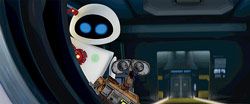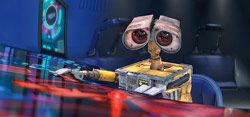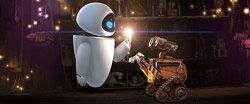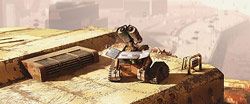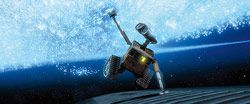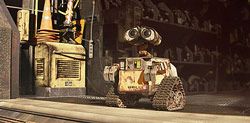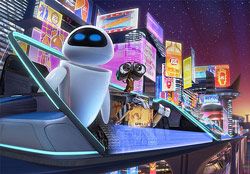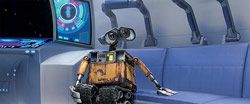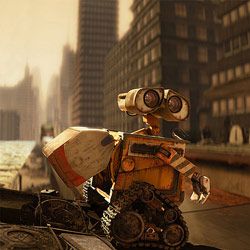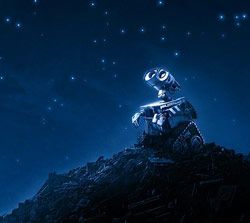After my trip up to San Francisco to visit ILM, I didn't think I'd be back up in the Bay Area again so soon, but duty calls. I was sent up to the other side of the Bay to visit Pixar Studios in picturesque Emeryville, California, but we weren't just there to take in the sights of this gorgeous studio facility... although I'm sure most of us wouldn't have minded staying longer. We were there to chat with the director, producers and some of the others who were behind the latest Pixar success, Wall-E, which comes out on DVD and Blu-ray on November 18. But, before we got a chance to speak with director Andrew Stanton, producers Jim Morris and Lindsey Collins, character designer Jason Deamer and sound and character voice designer Ben Burtt, we were shown around this immense facility.
This Emeryville facility sits on a 16-acre lot with the 220,000 square-foot building just a small part of the whole complex. It almost has a campus sort of feel to it, which suits the place nicely since there is an actual Pixar University housed there as well, which offers courses on a wide variety of things from filmmaking and beyond. Aside from the production facilities, there is a soccer field, volleyball court, basketball court, swimming pool, gym, outdoor amphitheater, two screening rooms, a main theatre, a massage room and a café. Not too shabby for a facility that used to be a Del Monte cannery.
Inside the main atrium, it has a real town square sort of a feel to it. There is a few little cafes on the ground floor, a gift shop (in which I had to pick up a Pixar t-shirt) and even a game room with some arcade games and even a ping-pong table that provided some entertainment later in the day for myself and a few others as we were waiting for our interviews.
We were shown around inside the main works as well, with their render farms and other production facilities. In most of the main hallways in the facility, there are loads of concept art and other items from Pixar's various films strewn about the wall, with each film getting a particular wing of the building to itself. Sadly, they wouldn't let us take picture of any of these goodies. What I also found out that was interesting on the tour is that Pixar employees are encouraged to make their own short films as well, and they're allowed to use any and all company resources to do so, which I thought was very cool and rare these days. As we moved through the building it seemed like we were walking through a timeline of the Pixar universe, with Wall-E getting the most prominent placement. The Wall-E gallery was pretty damn cool and featured some early design sketches and concept art. It was interesting to see how detailed these early designs were, with attention to detail even on specific moving parts within each drawing. They also had a series of colored scripts for the film and it was interesting to see how each draft evolved.
Andrew Stanton
There has to be a little bit of pressure on every director at Pixar to not be the one who screws things up.
Andrew Stanton: Well, to be fair, there is just as much pressure as you think, but that's way down the line on the list. Just to make these things, pretty much consumes every cell of your body. You feel like you're pretty much just fighting to make whatever the issue of the day or week is, work. You don't' have time to think beyond the next week so you don't really get that wide perspective, thinking about what the other films you've made when you're almost near the finish line. Frankly, I work with the most intelligent, funny people that I've ever met in my life that I think are pretty much smarter and funnier than I am. You feel like you have to show up and hold your own every day here. That's a more immediate personal pressure and it eclipses everything else on the day-to-day.
How is it, as a filmmaker, getting the DVD and Blu-ray done, coming out in the same year as the theatrical release?
Andrew Stanton: Well, it gets tougher and tougher because it seems, I don't know if it's true, but it seems that the window between when the film comes out and the DVD is released has become so much shorter that you almost have to do all your DVD stuff in parallel before you finish the film. I don't mind the behind-the-scenes stuff and it makes sense to capitalize off people getting interviewed right fresh when they're in the middle of it, because it's a journal of the moment and they're going to remember the details better than if you ask them later. You can actually maximize some of the work force. What I don't like is talking about it like it's done when it's not done. That just seems weird. I tried to push off doing the commentaries as late as I possibly could, because I just felt superstitious like I'm not going to talk about it like it's done or it's any good, when the jury is still out, we're still finishing it. That's awkward. I don't like that.
The film looks fantastic. Can you talk about the contribution of Roger Deakins?
Andrew Stanton: He would, if you ever get the opportunity to interview him about it, he will always be self-effacing and say, 'I was barely here. I had nothing to do with it, practically.' But I think he had way more of an impact than he'll ever realize. We've been working in the virtual world and most of us have never had the chance to experience physical moviemaking, in real spaces with real cameras and light. What it initially was, we heard he gave a weekend seminar, a sort of hands-on seminar of showing how he works, just the basics. We thought that would be great and we thought we would hire him to come up and do it for our crew. He came up on a weekend and it was so inspiring. I know, for him, it's just like A, B and C, but for us, I think that's his gift because he's able to take very complex problems and sort of find a simple solution for them. It's so deceivingly simple, these answers. Just put the light here, put the camera there. We were so inspired we asked him to stay for a couple more weeks and advise our director of photography, which is actually separated by two roles: the camera and the lighting are two different people, Daniel Feinberg and Jeremy Lasky. They basically hung out every day and any meeting that I was in with them, just to get a gist of how they work. He got it very quickly and really gave these, 'Well, if it were me, this is what I would do," kinds of things in conversation. It was really really helpful and we were at a point where we were not tying it down yet but trying to figure out what the look and the feel of the movie should be, and it was just this perfect sweet spot that he visited. It was great.
We read that Steve Jobs' designer, Jonathan Ive, had some input.
What qualities do you think someone needs to work here at Pixar?
Andrew Stanton: Well, that depends on the job because we're so huge now, it just depends. If there's one thing that is universal though, we don't suffer fools lightly. We were just talking about this the other day. For as much as we've grown, we're not really set up to work in an apprenticeship kind of mode, where somebody has to be coddled and handled. We work really well with very pro-active people, people that you almost have to get out of their way. We pretty much expect that once whatever is your job is handed to you, within the pipeline of making the movie, you will try to plus it without anybody trying to egg you on. Nobody is going to get mad at you that you added a better idea. When we were small, everybody was like that and we all sort of just found each other and we relied on that plussing to just happen when we worked on something. So, as we've grown, we sort of realized that is a quality that we kind of expect out of somebody who comes here. That's about where it stops. Everywhere else is just unique to the job.
This is obviously coming out on Blu-ray, but what about your first film, Finding Nemo? When will that and other Pixar films be coming out on Blu-ray?
Andrew Stanton: Well, I know that Nemo is slated to be one of the other films to eventually come out on Blu-ray. I'm not sure. I know we've done a lot of content for it so I know it's in the pipeline. I just don't know the release date.
Can you talk about 3-D-ing your older films for re-release?
Andrew Stanton: They've talked about Toy Story and Toy Story 2 being in 3-D to also sort of herald the coming of Toy Story 3 in 3-D.
Have you seen the footage of what it looks like in 3-D and what are your thoughts on the entire process?
Andrew Stanton: I have not, actually. I'm one of the few that have not in this building. I was so busy getting Wall-E out the door that I could never take the time for the meetings that they had to look at this stuff. I'm a little in the dark.
What's your feeling though, as a director, with Pixar moving into 3-D?
Now that we can see Wall-E on DVD and Blu-ray and pause and review it, what scene would you recommend to our readers to see it again?
Andrew Stanton: It's similar to all of our other movies, in that we had so long to polish these frames. There are millions of things to look at and there's so much detail. The thing I love about the Blu-ray is that it's the first time you'll be able to watch our movie exactly as good as we see it every day in this building. We always used to complain like, 'Well, this is the best it'll ever look for us. Everybody else it will always look worse,' the minute it leaves the building, whether you see it on LaserDisc or DVD. Even though it'll look good, nobody knows how much was really in there. Now when you watch the Blu-ray, it's pretty darn close if not exactly how good it looks for us.
Is there an extended version?
Andrew Stanton: No, but there are deleted scenes and two of them are actually finished scenes, which is actually rare for us, which means I screwed up because I really didn't see the problem until I got it all the way through the pipeline. The reason we've worked in storyboard form for so long, and most of our deleted scenes are storyboards, is because it's so expensive and so time-consuming to animate and finish it and you don't have time, nor do you want to spend the money to be wrong. You pitch it again and again in the drawing form, until you see that it exactly works. Then you animate it in CG. Usually, it's a one-to-one ratio. You get it right when you animate it. That's it. That means, that wasn't it, for two things that I did (Laughs). That's a testament to Pixar. We've always claimed that if we'd make 11th hour changes, we knew it would make the film better and that's exactly what happened with two moments. That's a real testament to my crew, who were very tired, almost at the finish line and I said, 'Guys, I screwed up. There are two things that...' What I love about it is they're so in it for the film. They're not in it for the paycheck. They really believe in the film so I knew that if I honestly explained to them why this would make the film better, that would give them the desire to keep going and it did. They all said, 'Oh my God, that's so much better' and they ponied up and did a miracle. They really turned it all around.
Were these changed scenes or could you tell us what these scenes are?
Andrew Stanton: Well, one was a scene where Wall-E, after they flew around the ship, Wall-E didn't give Eve the plans and tried to propose to her until they were hidden in this little sort of supply closet. It all happened there and it slowed the picture down. It was a necessary thing that had to happen between them, but just the pacing of the film slowed down. It suddenly dawned on us that he could quickly show her the plan up in space and it would motivate her to fly the ship much better. That would delay the proposal until when they were hiding behind the towel racks. There's a whole scene of events that you're used to seeing, but in it's own scene, all animated and finished. We ended up using the set very quickly somewhere else. Then there's a bigger one where I actually had it flopped wrong. I had Eve hurt and sent down to the trash and Wall-E rescued her. It suddenly hit me that it would be much stronger if Wall-E got incapacitated and everybody else had to rise to the occasion and made a stronger moment for declaring that she cared more about him than her directive. That was a sequence that was completely finished, so it's kind of wild. You see like a parallel universe, like, 'Am I drinking something?' They're exactly flopped and the little moments are a little different. It was kind of cool. There are a couple of gags that we did with Wall-E that had to go when I fixed it and now you finally get to see it at least in the deleted scenes.
Obviously you can pause the Blu-ray it and it will still look amazing. Are there any single-frame things that you want to tell fans about, that you might want to be on the lookout for?
Andrew Stanton: I don't think we've done these - not that I know of.
What about that collection of objects that Wall-E has on his shelves?
You guys are known for putting in little easter eggs to previous films.
Andrew Stanton: Yeah. There's definitely... if you look in the truck you'll find Mike Wasowski, you'll find Buzz Lightyear, you'll find Rex. The Pizza Planet truck is in the film, very prominently in a main scene. No one ever sees it. It has its own shot, actually, and no one ever sees it, which I guess means we're doing our job because we're making them focus on something else.
You guys are obviously developing films years in advance, as we've learned through the storyboard process, takes about four to five years. What films are in Wall-E that are coming up that fans don't know what the characters really are yet?
Andrew Stanton: Usually we only put an element of the very next upcoming movie. I'll be honest with you, I can't remember if we held that tradition with Wall-E and put something from Up into Wall-E. I guess I should be better prepared. We did drop the ball on that.
I remember in the original teaser trailer for this it said that Wall-E was one of the original ideas when they were dreaming stuff up. Was this kind of the end of maybe the first generation of Pixar?
Andrew Stanton: I don't know. I mean, that lunch got a little mythologized once we got the fully-formed ideas, like it was the only lunch we ever had. But it is funny that, out of that lunch, came A Bug's Life and Wall-E, but there were many other lunches and meetings that, eventually, those seeds turned into Monsters Inc. and Finding Nemo. It sounds sexier to say, 'Oh we walked up with finished scripts written,' but no. We eat every day together so there are a lot of meals where there are a lot of good ideas, a lot of lists of things. It's fascinating that this idea in particular came from that far back.
So what are you working on next?
Andrew Stanton: I think it's all out there. I'm working on a film, it's actually based on a book called The Princess of Mars and it's re-titled to be John Carter of Mars, for now. We're just writing right now, me and Mark Anders. We'll get all serious next year about when its schedule is and all those other details. It's a big sci-fi film.
Jason Deamer
When you first get the story, how does your process work? Are there storyboards intact already when you start working?
Jason Deamer: Well, It kind of depends, how early you get on to the production. I think Pixar is unusual in that the story is often evolving dramatically while we're working. But, at times, there's been a completely solid script and you might have an idea of who the voice might be. So you do some research and try to listen to the voice and have that in the back of your head when you're designing.
That happens that early on?
Jason Deamer: Sometimes, yeah. Like in Ratatouille, Linguini, Lou Romano, who was a great guy all around, he's almost a cartoon already. The director was like, "Make it look like Lou Romano" so we just designed it to look like him a little bit. Sometimes it's like that, but sometimes it's like, 'We need a lot of robots. Draw some robots' (Laughs). It really has that wide breadth of sources in a way.
What can you tell us about how human characterization at Pixar has changed over the last few pictures? It seems like some of the characters in The Incredibles and Ratatouille are really distinct.
Jason Deamer: Well, we made a really big leap, I think, in the The Incredibles. First of all, what's important to note, is 3-D animation, unlike 2-D animation where you can just draw what you want, you have limited resources to spend and, when it comes to computer modeling and articulating something, main characters get more of the love. The lead cast gets the most screen time, and whatever's left over, you spend the rest of your time trying to make look good enough. It's just unfortunate, but true. That's how it works. Until in The Incredibles, we never had leads who are humans, so arguably the hardest thing to do is a human being because we're so adept at recognizing a diseased-looking human. I think that's the source of when we get a revulsion from looking at them. Until in The Incredibles, we never spent our lead efforts on humans, so I think that's one big reason you've seen an evolution. Also, just the technology has just dramatically advanced. Each film we learn new tricks. You can think of it as a Model-T Ford that they started on before Toy Story and they've been adding on and souping up and now we're driving this crazy contraption. So, that's part of it and I think you might be seeing a similar hand because the sculptor, Greg Dykstra, I'm working with again and he's a really talented dude, and his hand is in all the maquettes, which he scans and we use as reference, for both Ratatouille and The Incredibles.
These films take a long time to make still, even with the technology improving. Has it sped up a little bit even with the technology increasing?
Jason Deamer: You know, it's really interesting, because they're so much more elaborate. Like with rendering times. It takes about 22 hours to render some of the biggest and most complicated shots, per frame, on A Bug's Life, and it was close to that again on Wall-E because even though these computers are exponentially faster, with all the simulation we're doing, the shots have just so much more math to be calculated. It really becomes a testament to doing the max that you can do. It's interesting, so no. It's taken the same amount of time, and what's even weirder is it takes the same amount of people and time, almost, to do a 2-D film. It's different, but it's similar in numbers, time-wise and people-wise.
With that frame of mind, are you guys constantly juggling projects? There's a new Pixar movie every year or two, so is it a lot of different projects at once?
What could you say about the challenges of the character animator in a movie where humans really take the backseat?
Jason Deamer: I'd like to believe, as character designer, my job is to push back, because animators want stuff that moves around, but I personally believe that limitations create stronger art and it's my job to push back and say, 'No. What can we do with this little bit?' With Wall-E, really what we tried to do was design the robots, the mantra that I had on the whole film was form follows function. Robots are very function-oriented things and if it was a robot who was supposed to clean the floor, make it do that job first and have all the extra stuff be secondary to that. Animators do amazing stuff with the little things.
What's your collaboration like as character designer between the animators? Do you give them the characters and they just animate?
Jason Deamer: It's very much a collaboration. The thing about design... how do I put this so I don't go into a huge long thing... basically, this is my philosophy, really great design comes from pushing shapes in forms to dramatic relationships that make things visually interesting. Where's a pen... (He proceeds to draw a smiley face.) This is your average smiley face. Well, it's not really interesting. Everything is equidistant. What makes it an interesting design, is do that. (He moves the smiley face towards the top of the head near the eyes.) It's got so much more character to it. Pushing these relationships is what makes the design. Having the mouth that close to the eyes, might make it impossible to... there's nowhere for it to go without hitting the eyes, so functionality elements come into play. A lot of the animation leadership is about stuff like that. They look at your designs and say, 'Well, we may or may not even be able to make that thing smile.' There's a lot of that push and pull, functionality versus what's interesting to look at. They're all artists in their own right so a lot of times they'll bring their own in. Pretty much the best idea wins around here.
How do you engage on research? Is there research on your end?
Jason Deamer: There is, yeah. We got to go to the trash dump. It was very glamorous. We also actually got to go to the jet propulsion laboratories in Los Angeles, which was an awesome experience, although, I have to say, I think they're a little disappointed in us because I think they were expecting Brad Bird and three of us younger guys come walking in (Laughs). These guys are all in their 60s and worked on sending people to the moon. Do you guys know who Jonathan Ive is? The Apple key designer? When we figured out Eve was probably going to be as different as possible from Wall-E, everything earthbound and square and dump truck-like, we wanted to make her, just so that their first meeting would be like two polar opposites meeting, the most futuristic we could make her, so we thought of iPod stuff. Steve Jobs had him come spend the day with us, which was actually a really amazing experience. He's a super-interesting guy.
So are you working on Up next then?
Jason Deamer: Nope. I leaped ahead to work on Newt.
Can you tell us anything about that?
Jason Deamer: I can't, really (Laughs).
Is there anything you like the most, in terms of characters? Do you like animal characters, people or robots? Some of the animals are so distinctive.
Jason Deamer: I'll tell you what. With Ratatouille, in the beginning, I couldn't draw a rat to save my life. Now I can just draw them and draw them and now that I can draw them easily, I really find them pleasurable to draw. It's always weird for me to see a movie, because I move on and they animate it, but watching Ratatouille, the humans, the subtlety and the action that they got was really impressive to me.
You made rats look personable.
Jason Deamer: Well, thanks. They're actually pretty cute, though. The only thing that makes them gross - I spent a lot of time looking at rats - if you stop and think about it, rats are pretty cute. You take away the beady eyes and then the hair on the tail is what really gets it.
Jim Morris and Lindsey Collins
Well, since we're here for home video stuff, I'll just start with what was the process like bringing Wall-E to Blu-ray, DVD, and did you feel like...because the short release span between theatrical and Blu-ray makes it difficult with time. Were there things you wanted to put on that you ran out of time on? Could you talk about what fans can look forward to?
Jim Morris: Well first of all, the really cool thing about the Blu-ray is that everybody can see the film in almost the full resolution it was originally made, so we're actually amazed when we watch it and say oh, yeah. Look at that detail we paid for to put into that movie. But there's a bunch of other things on the Blu-ray in particular. There's a feature that I think Cin-explore?
Lindsay Collins: Cinamexplore.
Jim Morris: Cinamexplore which is something that...just a name Disney's using for a particular thing that is kind of like the hot-rodded narration track by the director or others where in addition to hearing the comments and so forth about the film and the thoughts of the director, you're able to pull up images that relate to that. So if they're talking about a design problem with a particular scene, concept art can pop up and you can kind of get a view into that process and so forth. So for the people that are cinema buffs and so forth, I think it's really cool stuff and I'm one of those people. The other thing I like about the Blu-ray is the capacity for games on it. And particularly on "Wall-e" we have Pong in Wall-E. There's a little scene in the film. So a lot of us were inspired by those games in our younger years and there's a lot of kind of 8-bit game looking stuff. I think there's what...3 games that we had?
Lindsay Collins: Four, I think.
Jim Morris: Four? They're very reminiscent of Frogger.
Lindsay Collins: Like Wall-E's version of Donkey Kong.
Jim Morris: Donkey Kong and so forth. So they're actually...
Lindsay Collins: They're games we can play, that's why we like them.
Jim Morris: They're simple enough when I try to...
Lindsay Collins: I get this one. This one I know how to do, yeah.
Jim Morris: So those were a couple of the things that I liked about the Blu-ray.
Lindsay Collins: But to answer your question, yes it's really difficult given the release slate of how quickly these things can come out and how long they take to get done. We literally have to deliver the DVD material and the Blu-ray material on the day the movie releases. It's like literally that tight, so I mean you have Andrew, for instance, who was up doing post at Skywalker on the film who while they were mixing, before they were ready to play it back for him, was in another room recording commentary for the DVD, so it's crazy. They're right on top of each other.
Jim Morris: They're basically for all practical purposes delivered at the same time.
Lindsay Collins: In a way it's still fresh which is good. I mean you actually get to capitalize off of a production team and then a creative team that's still at that high powered gear. I mean we haven't ramped down and have to ramp back up for the DVD, so you get to capitalize on that but it is a tight, tight schedule.
Did you choose the extras for the Blu-ray? Did you have to plan it?
Lindsay Collins: Yeah we have a whole team actually.
Jim Morris: We have a producer here who runs a team and starting about a year from when we complete the film-even before then-we start talking about potential features and bonus material and things so we can start collecting or creating them if they need to be and it's a production. I mean, it's a little mini-production underneath the production.
Lindsay Collins: It's funny, it's like they were sending out mail to our team like fun facts. Like can you guys think of anything that's fun? They're like there's nothing fun right now! Nothing's fun! And they're like okay we'll ask again in a couple weeks. Just keep it in mind.
Jim Morris: We'll come back.
You're planning those at the same time you're producing right?
Jim Morris: There's no way around it now you know because the time horizon's so short between when....well when the material has to be submitted. I mean it's several months after when the DVD's or the Blu-ray come out but it takes them awhile to do the mastering and the authoring stuff they have to do.
There's other Pixar movies that have yet to be released on Blu-ray, and for fans, when can they look forward to seeing The Incredibles or Finding Nemo?
Lindsay Collins: Soon. They're working on it.
Jim Morris: They've got a timeline for putting those together and I'm not holding back anything, I don't know specifically.
Lindsay Collins: There are dates and schedules and release that they're wanting to just as much as you guys, we're wanting to get them onto DVD.
Is there any interactive stuff on the Blu-ray disc?
Lindsay Collins: Yes. BD-Live. We're as intrigued by BD-Live as you guys are in the sense that I think this is our first title that has it and so we haven't actually had a chance to mess with it yet because we don't have the DVD yet, but we're been hearing....they've been talking to us about kind of what the capabilities are and it sounds pretty cool that you can actually schedule kind of viewing parties with your friends from around the globe and sync it up and then chat with each other about it and send mail and all that kind of stuff, so it seems like a pretty cool thing.
Jim Morris: Yeah, but I fear it. I just feel it'll be another black hole you get sucked into like all our other communication devices. No, it's good especially for people who are into movies and have friends and families in kind of remote locations and can kind of share those experiences.
Lindsay Collins: Sync it up to Darkside of the Moon and turn off the audio track. Actually one of the cool things apparently is you'll be able to download actually is a sound-effects only track eventually which is a Ben Burtt track only and if you do BD-Live you can download it onto your player and just play it that way.
Jim Morris: And they can continue to add those features to it. That's sort of the thing, I guess you get to become a member for life or something.
Lindsay Collins: Yeah, pretty soon you'll have the cafeteria staff. It's like hi, I'm here to talk to you about my contributions in Wall-E like downloaded about a year from now. Everybody will have their track.
You guys, being the producers of the film, certain producers in the Hollywood system will be multi-tasking and working on 5 different projects. Are you guys, you know, day to day on one project at a time?
Lindsay Collins: Jim is, that's just because he has another job.
Jim Morris: Well, yeah. I was in particular on this film because I was overseeing the other films as well as a production executive. But we are also helping Andrew with his future projects-Lindsay is-and you know there's at Pixar...Lindsay jumps in on other people's projects to help out and I oversee other projects and then we've got our projects so to speak that we're working on. So there's a lot of stuff always kind of going on and Lindsay's helping out with a couple projects that are in production or going into production here as well. So there's always a lot of stuff on the plate.
Lindsay Collins: Only because people that are going to be working on them are busy working on other things, I mean you know it's a collaborative to the nth degree. I mean, it's literally like who's got a second? You know?
Is a lot of it just because these take so long to come out and to actually make these things like 3 or 4 years?
Lindsay Collins: Yeah, because these guys just keep wanting to do more and more, you know. I mean it's like we have more and more stuff going on. I mean we have theme park stuff happening. We have DVD stuff happening.
Jim Morris: We have a movie a year to begin with but when you think about what that means is something you have a movie a year and then a DVD a year and a Blu-ray a year for that, oh yeah and then there's the library stuff that we need to start working on and there's theme park stuff and there's little other types of short films that we're making and promo stuff. We've made a whole lot of little sort of short vignettes of Wall-E and some of the other characters that were used to promote the film. Oh, they're on the DVD and Blu-ray as well. There's just a whole bunch of stuff going on so we try to load balance as best we can.
I love a lot of the shorts, too. Has there been any talk about turning any of those into full-length like Lifted or any of those?
Jim Morris: I'm trying to think. None of the ones at the moment have been talked about. You know, they tend to be more of a launching platform for the director's who make those to go on and pitch other ideas. I can't think of any that have that. It's certainly a possibility.
Yesterday there was an announcement that Cars 2 bumped up a year. How does that impact everyone at Pixar when you all of a sudden changed a year?
Lindsay Collins: It's fun.
Jim Morris: We drink a lot more.
Lindsay Collins: It was really early. I mean the nice thing is because these take a while to make that there are several shows right now that are in that really early stage of getting the story together and developing and stuff like that and getting the script and showing their first set of reels or something. It allows...especially at that point, that's really our only time for flexibility. Kind of once you start really getting into the production pace it's like you're basically running for the finish line, so at that stage I think Cars 2 and Gary's project, it's like one of those like okay, who feels ready to go on Cars 2? And they're like we're ready, we're gone. Let's do it.
Lindsay Collins: And the crews are so small right now that it's just a matter of who do you stack up first.
Jim Morris: Yeah, who's looking...because these movies-one of the things we do here is try to take the time to make sure the movie's what it should be and some of them fall into place quickly and others like Wall-E for example, you know, as kicking around for years until it actually got the right shape and we really greenlit it and moved it forward.
Lindsay Collins: And also to be honest, one of the hardest things about writing these stories is coming up with the characters and making sure they're lovable in designing them and it's something that a sequel has, you know, advantage over an original film is that you actually know the characters, at least the main ones...and the universe you're in so it actually takes....so much of what's difficult about that first year- year and a half is fine-tuning that and figuring out what the look of your film is and how...
Jim Morris: What the rules of your universe are and those kinds of things.
Lindsay Collins: It allows them...it gets them a little further ahead.
When are you writing the sequel then for Finding Nemo? Does it have a sequel?
Jim Morris: You know whether we make a sequel or not here is really in the hands of the film makers and Andrew, who made Finding Nemo originally had other ideas he wanted to do and was not as anxious to move into doing sequels. Although he has been a key player in terms of the Toy Story sequels, John Lasseter, by comparison, once he sort of creates a universe, he loves the idea of exploring more and doing more with those characters, so Cars is sort of his movie. He's not directing this film but he's playing a heavy creative directing role in it. Brad Lewis is actually the director of the movie and Lee Unkrich is doing Toy Story but John likes to sort of extend the storytelling within those worlds. Andrew likes to explore new ideas so we get this different...the same's true with Pete Doctor who made Monsters Inc.. He...and there will probably be because he's receptive to doing a sequel to that at some point, but he really wanted to do this movie Up which comes out next summer. Different movie and he has another original one after that. So some of it's the artist's temperament and whether they want to stay and explore one world or whether they want to try some new places out.
I was going to ask provided the gestation period for each film and each project-this might seem a little granious but are there things that you notice as producers about the evolution of Pixar or are you kind of really immersed in process for the singular project at the time?
Lindsay Collins: You know it's funny because it's a studio that's so close knit and it's got thank God such a great reputation and everybody thinks like oh, these are Pixar films and stuff. That's all true. I think that the flip side of that is that we have these great directors here and it's more like it's like Andrew Stanton has his films and Pete Doctor has his films and John Lassiter has his films and those seem to feel similar one to the next. You see an evolution if you will as a director, I think, more than you necessarily as a studio because I think they come from such a diverse kind of places with different ideas and different stories they want to tell and you have new ones coming up and more experienced ones that people ask if there's sort of a global evolution of Pixar and I don't think so. I don't think that's ever been the goal nor do I think it's actually what the reality is. I think the reality is more that you see evolutions of filmmakers here both new ones coming up through the ranks and ones that are kind of doing 2, 3, 4 films here at Pixar and you kind of can track that better than you can necessarily can track an evolution for Pixar as a whole.
There's been a lot of talk about you guys retro-fitting older movies like Toy Story and Toy Story 2 into 3D. And I wanted to know if you've seen any of the footage and what does it look like?
I have to ask you, George Lucas is famous for going in and completely changing and fixing things. Are you changing anything to the story?
Jim Morris: Not a thing. We're not changing a thing in the movies. We're not changing the timing, story, pacing, the shots, anything and so what we're doing is going in an making a 3D version because you can set the conversions and the ocular offset and there are a number of things in making a 3D version. We're doing it that completely preserves the original movie in terms of everything about the story. There's no new shots. There's no new nothing. It's exactly the same movie you saw before.
IMAX became a big thing after The Dark Knight this summer and really revolutionized what cinema going can be. Is there any thoughts at Pixar to incorporating the IMAX format into your movies, 3D all that other stuff in the future?
Jim Morris: Well, we've always talked about doing an IMAX stuff and never had it come quite to fruition. We've haven't found the right thing. We're not specifically talking about an IMAX release at this point in time but we would certainly agree with you that The Dark Knight stuff was really...great and innovative in that direction. 3D, you know Up is coming out as our first 3D film and is the first one to try to make I guess I'd say more aesthetic use of the stereo as opposed to...
Lindsay Collins: And Toy Story 3.
Jim Morris: Yeah and Toy Story 3.
So Toy Story 3 is definitely 3D?
Jim Morris: Oh yeah.
Lindsay Collins: Both. I mean Toy Story and Toy Story 2 are being re-released only in 3D. But Toy Story 3 is being released both in standard def and 3D.
Jim Morris: Unless there happened to be 6,000 screens by that time.
Our last stop of the day was for a little demonstration and Q&A from the man who brought Wall-E's voice to life and provided the other sounds of the movie as well, sound and character voice designer Ben Burtt. While Burtt has only been with Pixar since 2005, he has quite a legacy that spans over 30 years. He received his first credit as the sound designer of Star Wars: Episode IV - A New Hope in 1977, earning his first Oscar and creating some of the most iconic sounds in film history like R2D2, C3PO, lightsabers and Darth Vader's breathing. He's also received Oscars for sound editing in Raiders Of The Lost Ark and for sound effects editing in E.T. the Extra-Terrestrial and Indiana Jones & The Last Crusade. He is also accomplished in several other fields of production as well, with credits in writing and directing and he also served as editor on the Star Wars prequel trilogy as well. We all sat in one of the Pixar campus' auditoriums for a wonderful demo on how Burtt provided the auditory materials for Wall-E.
First off, Burtt described his job as a whole and how this job differed from some of the big jobs he's had in the past.
He then went on to explain that, "most of the sounds we use in the movie, are real sounds." He then played a number of sound files for us and explained how those sounds were achieved by practical means. There was the wind sound, which was made by dragging a canvas. "Like many good sounds, they're results of accidents," he said in describing how he was actually dragging this canvas through the studio. When he actually dragged the canvas on the stage for us, it sounded just like the audio file he just played. The magic of movies, folks.
He went on to talk about the sounds of Wall-E's movements that he made from an old World War II generator that he saw in a John Wayne film and subsequently found on eBay. Some of the coolest sounds, however, were the sounds of Eve. For the flying sound they actually recorded a mini-jet that flew over their heads, but Eve's laser weapon sound was probably the most uniquely performed sound we heard all day.
"I've done a lot of laser guns in my life and I thought, at one point, I'll never be able to come up with another one. I thought about the ways I've done them before, and I came up with a variation of the process and it starts with, what looks like a Slinky, is actually a coiled spring which is used in physics lectures to demonstrate the propagation of weight. You have it usually horizontally shaped and you can see waves, but I knew from experience as a kid, that hitting a Slinky makes an interesting sound, a very quiet sound. What we have now is a Slinky hanging down and attached to a metal plate, like a little guitar pick-up and if you hit the spring at the top, all you hear is a clunk, like you'd expect. But if that sound travels down the spring, the high frequencies travel faster than the low frequencies, so they get to the bottom first. The highs come first, then the mids, then the lows and you end up with something like this." It sounded so much like a synthesized computer sound I was just amazed. So, if you want to make people think you have a blaster or a laser or something, here's what you need: a ladder, a Slinky (or one of those physics springs) and a metal bar. Damn that was cool.
After that awesome demonstration he opened it up to questions from the press corps, and here's what this Oscar-winning sound engineer had to say.
Ben Burtt
What was the hardest sound to come up with in Wall-E ?
Has your relationship with Pixar been so good that you're staying on for now?
Ben Burtt: I'm staying on with Pixar and right now I'm working on publicity. It's been non-stop since the feature came out a few months ago. I just got back from Germany last night, the film opens in Germany today. I was doing some press junkets over there. Once this is over with, in a month or so, I come back here and pick up another project but I don't have any specific information to give out on that.
So what's your process like when you first start a film?
Ben Burtt: Usually when I work on a film, I go background to foreground. That's the way. When you look at a scene and you see Wall-E out in the toxic waste, so the first thing I need is some kind of background sound that gives me a sense of the place. Then I begin working toward what next layers need to seem real.
You said some of the best sounds are created by accident. Are there any other sounds in this movie that were just happened upon, besides the one you showed us?
Ben Burtt: Oh boy. I said that, didn't I. What happens is you go out to record something and you get something else. A good accident... oh yeah. I went out to record a policeman's taser. There are a lot of robots electrocuting each other in this movie and I wanted to get a nice buzz or a snap from electronics. I live near a policeman and I asked him to come over and he brought a belt full of tools. When we did the taser, it wasn't very interesting. It was just a pop and click. So I said, 'How about your handcuffs?' We started clicking them and opening and closing and we used that for the little cockroach in the film, the little body movements. There were some chirping sounds in there, but the clicking is the handcuffs. I was in the gym at lunchtime and someone was bouncing on one of those fit balls, exercise balls. So we got all the balls together and shoved them down the hall down the stairs. We used that for all the falling and sliding all over each other. To me, it's an ordinary thing to go out and try to record something and then you try to hear what the components of it, what it's used for. It's always fun.
What would you say is the ratio of the actual real sounds you recorded to electronic sounds?
Wall-E Image #14Ben Burtt: Well, you know, it's difficult to give you the actual stats. I don't have a calculator in front of me. This film had lots of electronics in it. There's hardly a scene in it where someone's not pressing a button with a beep, or so many forcefields in this film. If you stop to think about it, when ever a robot is floating or a shimmering energy, there's more forcefields than any science-fiction film ever made. So, for those types of things, I generally do synthesize. If I had to just throw something out there, I'd say that 25% of it is electronic and 75% is organic or, that is, made out of the real acoustic sounds that you can find anywhere.
With that, our chat with sound legend Ben Burtt and our day at the gorgeous Pixar Studios facility came to a close. It was quite the entertaining trip and I surely hope to revisit this Emeryville, California studio a few more times in the future. Thanks for coming along on this awesome journey through one of the hottest studios in the biz today. Wall-E comes out on DVD and Blu-ray on November 18. Peace in. Gallagher out!

